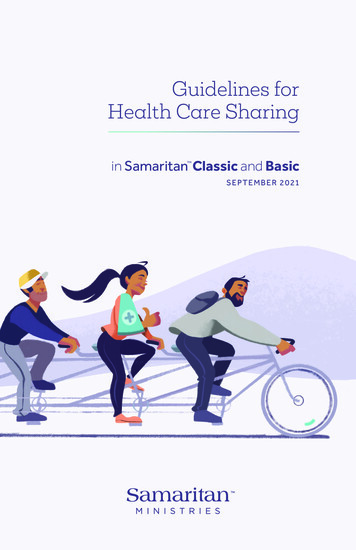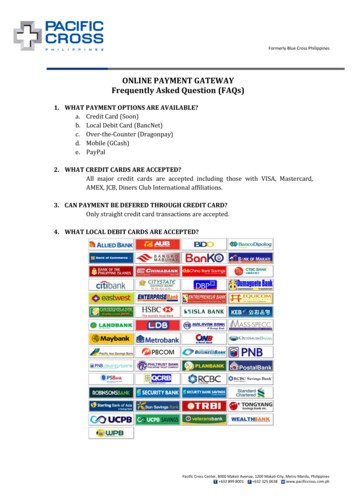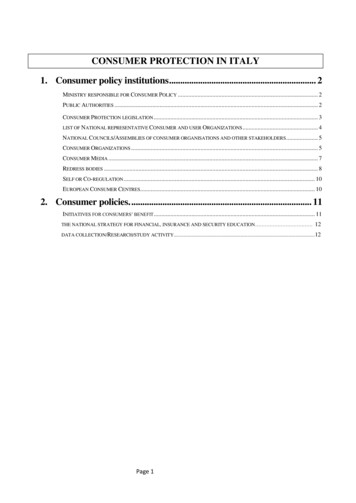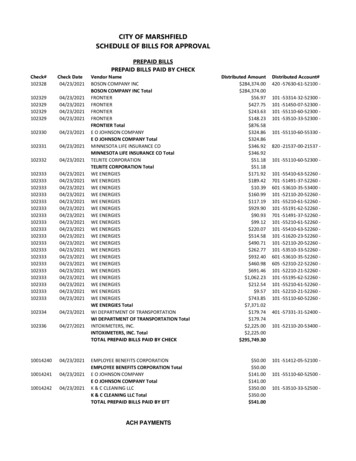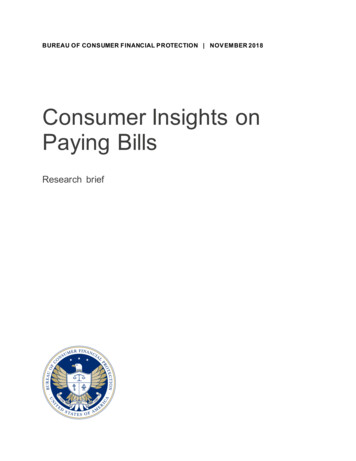
Transcription
BUREAU OF CONS UMER FINANCIAL P ROTECTION NOV EMBER 2018Consumer Insights onPaying BillsResearch brief
Table of contentsTable of contents .1Executive summary .21About the study.32Consumer challenges with paying bills and managing cash flow .43Potential solutions for consumers .8413.1Survey findings on challenges of paying bills . 83.2Testing a tool to faciltate bill due date changes . 9Implications for financial education .12CONSUMER INSIGHTS ON PAYING BILLS
Executive summaryThe Bureau of Consumer Financial Protection (Bureau) has conducted research showing thathaving control over day-to-day, month-to-month finances is an important element of financialwell-being. 1 But many consumers struggle to make ends meet. In our 2015 national survey onfinancial well-being, 43 percent of people reported that covering expenses and bills in a typicalmonth is somewhat or very difficult.2Financial education cannot directly address certain underlying causes, such as scarcity offinancial resources and unpredictable income and expenses. Other challenges, however, stemfrom factors that can be addressed, at least partially, through financial education to helpconsumers learn new skills and use new tools. The Bureau looked at a number of these commonchallenges to find those that financial education could potentially address.Because some consumers struggle to pay all their bills in a timely manner, the Bureau focusedon paying bills as an area for potential solutions. Bureau research3 found that empoweringconsumers to do something as simple as changing bill due dates to better line up with incomecould help some consumers better manage their cash flow. In cases where billers cannotaccommodate these requests, consumers can take other steps that begin with understandingtheir cash flow and bill schedule.This approach builds on one of the Bureau’s five principles for effective financial education. 4This principle—Make it easy to make good decisions and follow through—suggests that tools21Bu r eau of Consumer Financial Protection, Financial well-being: The goal of financial education (2015),con sumerfinance.gov ng/.2Bu r eau of Consumer Financial Protection, Financial well-being in Am erica (2017), consumerfinance.gov /datar ica/.3T h e study was conducted by Behavioral Labs, Inc. (also k nown as ideas42) under contract with the Bu reau a fterselection through a com petitive solicitation (contract number T PD-CFP-1 2-C-0020).4Bu r eau of Consumer Financial Protection, Effective financial education: Five principles and how to use them(Ju ne 2017), consumerfinance.gov l-education-five-principlesa n d-how-use-them/.CONSUMER INSIGHTS ON PAYING BILLS
and approaches that make it easier for consumers to pay bills on time can help them movetowards financial well-being.This report offers insights from a review of existing research into consumer challenges withmanaging cash flow and paying bills. It summarizes results of a consumer survey regardingconsumers’ experiences in this area. It also summarizes user testing of a bill due date alignmenttool to help consumers with this challenge. With greater understanding of the challenges relatedto cash flow and bill paying, the Bureau hopes to spur efforts to support consumers in makingchoices that result in the outcomes those individuals want to achieve. The Bureau hopes that theconsumer insights in this report will provide actionable ideas to financial educators and industrythat can help consumers achieve greater financial well-being.1. About the studyThe goal of this research was to identify financial decision-making challenges faced byconsumers and to design and test strategies that can help people address those challenges.As part of this work, the Bureau worked with a private-sector entity to better understandconsumers’ experiences with managing cash flow and paying bills and to test solutions to thesechallenges. 5 A survey of 446 consumers (customers of a bill paying service) reinforced theBureau’s understanding of challenges consumers who struggle to make ends meet may face inpaying bills. In particular, the Bureau learned that alignment of income and billing dates isimportant: 50 percent indicated that “Due before I got paid” was an important reason for fallingbehind on bills, and 40 percent responded that “The way I get paid does not line up with payingbills.”Through online user testing with 229 consumers, the Bureau developed and refined prototypetools to address this challenge that were functional and had high levels of consumer interest and53T h e Bureau worked with a private-sector bill payment processor that serves telecom , wireless, cable, and utilityn etwork operators in North Am erica. This com pany had a Mem orandum of Un derstanding (MOU) with t hecon tractor for this project, Behavioral Labs, In c (see footnote 3) t o share its findings from the prototype r esearch.T h e com pany’s participation was determined through an open process for organizations t o express interest inw or king with t he Bureau of Consumer Financial Protection and Behavioral Labs, Inc. on the project. Seeh t tp://www.consumerfinance.gov /blog/were-looking-for-innov r m ore details. Working with t hese com panies does not constitute an endorsem ent of these com panies or theirpr oducts on the part of t he Bureau.CONSUMER INSIGHTS ON PAYING BILLS
demand. The research team prototyped a bill due date scheduling system to support consumersin aligning their bill payments with their income.The consumers who provided feedback were demographically diverse, although not statisticallyrepresentative of the overall population. Their feedback should be treated as suggestive of someconsumers’ experience in managing cash flow and paying bills. The results are not intended toprovide statistically significant data that can be generalized to all consumers, but they provideinsights that can support further efforts to support consumers in managing their money to reachtheir own goals.2. Consumer challenges withpaying bills and managingcash flowManaging money to make ends meet is one of the biggest challenges consumers face in theirfinancial lives. In a national survey conducted by the Bureau in 2015, 43 percent of consumersreported that covering expenses and bills in a typical month is somewhat or very difficult. In thesame survey, over one third—34 percent—of all consumers surveyed reported experiencingmaterial hardships in the past year, such as running out of food, not being able to afford a placeto live, or lacking the money to seek medical treatment. 6 Some consumers may struggle tomanage their cash flow and pay their bills in a way that prevents negative consequences such aslate fees, higher interest rates, or loss of a valuable asset like a home or vehicle.To find ways to educate and empower consumers to improve their ability to make ends meet, theBureau looked into factors that contribute to the challenge. Not all of these factors can beaddressed through financial education, but effective financial education starts with learningabout the real challenges consumers face. Assessment of these external factors can form thebasis for tailoring financial education efforts and setting realistic expectations about howfinancial education can help.64Bu r eau of Consumer Financial Protection, Financial well-being in Am erica (2017), consumerfinance.gov /datar ica/.CONSUMER INSIGHTS ON PAYING BILLS
Existing research points to many factors that contribute to the struggle to manage cash flow andbills, including the following:Lack of financial slack. Juggling bills can be challenging for consumers whose income justbarely covers their expenses. Almost 80 percent of consumers report living paycheck topaycheck.7 One in four consumers do not pay all of their bills on time. 8 One-fifth of adults expectto leave some regular monthly bills at least partially unpaid. 9When consumers fall behind, decision-making may become more complicated and make thestakes higher. As the number of bills and notices grows larger, calls from bill collectors canbecome more frequent.Unpredictable income and expenses. Income volatility can also make the challenge ofmanaging bills more acute. More than one in three households experience large changes inincome year over year, and those who experience such income volatility have less in savings andreport lower financial well-being than those who do not. 1 0Additionally, when managing bill and debt payments, consumers must consider different duedates, variations in bill amount, and unexpected expenses. Utility spikes in winter or summercan cause bill sizes to vary. Other unexpected expenses can include medical emergencies, homerepair, or vehicle maintenance.Such complexity and variability in both income and cash outflows can also cause stress. Thisstress may even affect consumers’ ability to plan and make payments on time. 1 1Facing these challenges, consumers may deplete income when it arrives, leading to shortfallslater.Prioritizing bills involves complex decisions. On average, U.S. households pay about 13bills per month. 1 2 These may include mortgage or rent, car payment, electricity, landline phone7Ca reerBuilder, Living Paycheck to Paycheck is a Way of Life for Ma jority of U.S. W orkers (2017).8Na t ional Foundation for Credit Counseling, The 2018 Consumer Financial Literacy Survey (2018).9Boa r d of Gov ernors of t he Federal Reserve Sy stem, 2017 Survey of Household Economics and Decisionmaking(2 017).10Pew Charitable Trusts, How Incom e Volatility In teracts W ith American Families’ Financial Security (2017).For r esearch on the intersection of st ress and decision-m aking, see Sendhil Mullainathan & Eldar Shafir, Scarcity:Why Having Too Little Means So Much, T ime Book s (2013).11125Post a l Regulatory Com mission, T he Household Diary Study: Ma il Use & A ttitudes in FY 2015 (2016).CONSUMER INSIGHTS ON PAYING BILLS
and mobile phone, cable TV and internet access, home and car insurance, water and sewer,credit cards, and student loans. In addition, many consumers receive intermittent bills forexpenses like medical care, home repair, or vehicle maintenance. When there is not enoughmoney to cover bills in a given month, or a mismatch in timing between bills and income occurs,consumers must prioritize.In order to effectively prioritize, consumers might need to compare consequences of being lateon different bills and debt payments. However, consumers may find it hard to compare differentkinds of consequences. Consequences may vary from late fees, interest payments, or credit scorereduction, to having a service turned off or foreclosure or repossession. Some consequences,especially nonfinancial ones, can be more difficult to evaluate than others. 1 3These challenges may cause consumers to prioritize bills with immediate late paymentconsequences, such as wireless phone service disconnection, over bills with greater potentiallong-term consequences, such as eventual eviction or foreclosure.1 4 Similarly, thoughresearchers have found the rule of thumb “pay off small debts first” to be a successful strategy tobuild confidence and motivation in debt management, 1 5 focus on short-term accomplishmentmay lead consumers to overlook longer-term consequences such as foreclosure or repossession.Multiple communication channels to track. Consumers can receive information abouttheir bills via the mail, by phone, or electronically. Electronic bills can be posted to a website ordelivered via email. Then, consumers can pay bills through a variety of channels, including cash,paper check, money orders, or electronic funds transfer (EFT). These advances in billing andpayment methods, resulting in multiple means of receiving and paying bills, may alsocomplicate the process of paying bills.On the surface, these options would seem to make things easier, and more consumers are takingadvantage of the convenience of paying bills electronically.1 6 However, as consumers add newmethods of payment, they often do not discard the old ways, leaving them with more accounts,cards, and channels to track. 1 7 Most consumers now have at least two bill receipt channels, such13Ch ristopher Hsee, The Ev aluability Hypothesis: An Ex planation of Pr eference Reversals Between Joint andSeparate Ev aluation of A lternatives, 67 Organizational Behavior and Human Decision Processes (1 996).14Kr istin S. Seefeldt, Constant Consumption Sm oothing, Limited Investments, and Few Repayments: T he Role ofDebt in the Financial Liv es of Econom ically Vulnerable Families, Social Service Review 89(2) (2015).Da v is Gal & Bla keley B. McShane, Can Small Victories Help Win the War? Evidence from Consumer DebtManagement, X LIX Journal of Marketing Research 487 (2012).15616T SY S Payment Solutions, 2016 U.S. Consumer Payment Study (2016).17Scot t Schuh, Federal Reserve Bank of Bost on, Consumer Payment Choice: A Central Bank Perspective (2012).CONSUMER INSIGHTS ON PAYING BILLS
as mail and online, and at least two methods of paying bills such as paying by check or byelectronic payment. This means that many bills now have at least four different paths tocompletion. Also, digitization has done little to simplify bill timing. This complexity around themethods and timing of both billing statements and bill payments may make it even harder forconsumers to develop a way to manage their bills and prioritize the payments in lean periods.Challenges with automatic payment. Only about 32 percent of bills are paid by means ofautomatic or recurring payment 1 8 even though these tools can prevent late payments, reducehassle, and generally simplify bill and debt payment. Many consumers say enrollment hassles,lack of trust, a preference for paper bills, or fear of overdraft keeps them from using automaticpayment. 1 9Going it alone. Exacerbating many of these other challenges, many consumers deal with billson their own and are reluctant to ask for help. 20 Consumers may feel that personal bills are tooprivate a matter to ask friends and family for advice or help. Finances rank low on lists of whattopics are discussed with friends and are unlikely to be discussed with strangers or online. 21Not using a budget. Despite juggling multiple bills and deadlines, only 19 percent ofconsumers report they have a comprehensive financial plan. 22 Many consumers manage billsand finances on an ad hoc basis, and roughly half of consumers say they do not use a householdbudget. 23For the many consumers who do not use a household budget, the lack of an efficient system tomanage cash flow and organize bills and debt payments might compound the difficulties ofmismatched timing and complexity.18A CI W or ldwide, How19Americans Pay Their Bills (January 2017).A A RP, Consumer Payment Study (2007).202 7 percent of h ouseholds are one-person households and 67 percent of couples say t hat on ly on e of t he partnersm anages household finances. U.S. Census Bureau, America’s Families and Living Arrangements (2010); RichMor in & D’V era Cohn, Women Call the Shots at Home; Public Mixed on Gender Roles in Jobs , The Pew CharitableT r usts (Sept. 25, 2008).Mer edith Ringel Morris et a l., What do People Ask their Social Networks, and Why? A Survey Study of StatusMes sage Q&A Behavior, in CHI ’1 0: Proceedings of the SIGCHI Conference on Human Factors in Com putingSy stems 1739 (2010); Peter Ma rkham, Gossip with the Girls but Men Only Have Four Subjects, Da ily Ma il(Lon don), Dec. 12, 2012; AARP, Personal Finances: The Final Frontier for Social Media (2009).21Cer tified Financial Planner Board of Standards, In c. and the Consumer Federation of Am erica, Financial PlanningProfiles of American Households: The 2013 Household Financial Planning Survey and Index (Sept. 2013).22237FINRA Inv estor Education Fund, Financial Capability in the United States 2016 (Ju ly 2016).CONSUMER INSIGHTS ON PAYING BILLS
3. Potential solutions forconsumers3.1Survey findings on challenges of payingbillsAfter reviewing existing research, the Bureau worked with a private-sector bill paymentprocessor to survey its customers to learn more about consumer experiences with paying billsand consumer interest in specific solutions.24The 446 people who responded to the survey are not a statistically representative sample.However, their answers provide insight into common bill-paying challenges among people whostruggle to make ends meet. Nearly half of the respondents had income below 25,000 andanother 30 percent had income between 25,000 and 49,999; 37 percent were under 35 yearsof age; and about three-fifths were female.Overall, only 21 percent of respondents reported that they always pay their bills on time. Thirtynine percent reported mostly paying bills on time, and 40 percent reported that they sometimes,rarely, or never pay bills on time. Younger respondents and those with income below 75,000 ayear were substantially less likely to report paying all their bills on time. Half the respondentsreported having to juggle bills always or most of the time.Many respondents said they fall behind on bills because of a timing mismatch between thearrival of income and billing dates. Many specifically indicated that bills come due beforepayday, and many others generally report that their income streams do not match bill due dates.When asked to rank the reasons why they did not pay bills on time, alignment of income andbilling dates is an important factor. 50 percent indicated that “Due before I got paid” was animportant reason, and 40 percent responded that “The way I get paid does not line up withpaying bills” was an important reason.These particular survey results confirmed the income/bill due-date mismatch as a promisingarea for solutions. The next step was to test a prototype of a bill due date change tool that wouldempower consumers to identify and request bill due dates that would better align with pay days.24T h e Bureau worked with a private-sector bill payment processor that serves telecom , wireless, cable, and utilityn etwork operators in North Am erica. See footnote 5 for more details.8CONSUMER INSIGHTS ON PAYING BILLS
3.2Testing a tool to facilitate bill due datechangesBureau researchers tested a prototype of a bill due date change tool to support consumers inaligning their bill payments with their income. The idea was to set up a way that consumerscould view their billing information in one place with a simple monthly visual planning aidshowing pay days and bill due dates. Then, consumers could line up payment dates and incomeinflows to see which regular bills are likely to be mistimed and cause potential shortfalls. The billdue date change tool could help consumers reach out to billers to negotiate timing of billing andpayments. For example, a feature could generate letters to billers to request a change of duedate, a payment plan, or other changes to reduce the risk of shortfalls.The researchers tested the prototype bill due date alignment tool with a group of 229 consumersthrough online user testing. These consumers filled out a form with information about the billthey wanted to change (e.g., the biller, current due date, and preferred due date). Additionally,consumers listed how they would like to request the change (e.g., contacting the biller directly orhaving a third party contact the biller). These consumers were then asked a series of questionsaimed at gauging demand for the tool. 25The research found that there was significant consumer interest in changing bill due dates toalign bills with income. 80 percent of the consumers who tried out the prototype indicated aninterest in following through on changing the due date for their bills.Here’s how the consumers who participated in the user testing used the bill due date alignmenttool:Knowledge. Most consumers testing the bill due date change tool reported that they had nevertried to change billing dates because they simply did not know they could.Bills. Most consumers were easily able to identify at least one bill with a due date they wantedto change. The most common selections were utility bills and phone bills.Preferred due date. Consumers then identified a due date other than the current due datethat they felt would better match their income. The bill due date change tool suggested either the25A s t his t est was intended to determine consumer dem and, t he prototype bill due date change tool did not actuallysen d bill rescheduling requests t o billers, but instead sim ulated the st eps the consumer would t ake t o followt h rough. After presenting consumers with the t ool, participating consumers were a sk ed a series of qu estions aim eda g auging demand for this service.9CONSUMER INSIGHTS ON PAYING BILLS
first or seventeenth day of the month, since those dates are likely to immediately follow abimonthly payday. Most consumers selected the seventeenth day of the month, many selectedthe first day of the month, and others selected dates near the end of the month.Change request method. Finally, the bill due date change tool gave consumers choices fornotifying the biller of the due date change request. More than half of consumers wanted a thirdparty to contact the biller to request the change. Other consumers preferred more personalcontrol over the process and requested a form from the third party that the consumers couldcomplete and send to the biller.Prior experience with changing bill due dates. Some participating consumers (38percent) said they had previously requested to change a bill due date on their own.Of those that reported trying to change a bill due date, most (61 percent) called the billerdirectly, 14 percent used an online form on the biller’s web page, and another 14 percent went tothe biller’s office directly.Most of these efforts were unsuccessful, either because of billers’ policies or because of issuesrelated to customer service and communication. Of those who tried to change their due datepreviously, only one-third (36 percent) succeeded in changing their due dates. Many consumerswho had tried unsuccessfully to change their due dates expressed frustration at billers’ policies,customer service, and communications.Among those who had succeeded in changing a bill due date, half said they picked a day afterthey were paid. Another 19 percent said they picked a date when other bills were due so theycould make payments at the same time. One out of seven (14 percent) said they picked a datethat was easy to remember (for example, the 1st or 15th).10CONSUMER INSIGHTS ON PAYING BILLS
4. Implications for financialeducationIn summary, the Bureau heard from consumers that they value the ability to manage their dayto-day, month-to-month finances. This is a foundation of financial well-being. The goal of thisresearch and development effort is to help address conditions that lead to late bill payment andthe negative consequences that flow from paying bills late. The prototype tool is one example ofhow to do this by helping consumers to better align their due dates with their income.This research has implications for multiple audiences:Consumers. Consumers can think through their monthly income inflows and outflows toassess whether changing bill due dates would be appropriate to their situation. If desired,consumers can then reach out to their billers to request such a change. See the consumerworksheet that is a companion to this brief, Request a change in your bill due date. When a billercannot accommodate a due date change request, consumers can use other Bureau tools such asthose in the box below to better manage their cash flow.Financial education professionals. Financial educators can use these findings to helpconsumers with challenges related to managing cash flow and paying bills. Financial educatorscan help consumers create budgets, track income and bills, and request changes to bill due datesif appropriate. (See Bureau tools and resources on this topic in box below.)Billers and other private sector entities. The concepts underlying the prototype testedcould be adopted by a variety of entities that bill consumers. By making it easier for consumersto set bill due dates, billers who are able to be flexible could meet consumer demand for thisservice while also potentially improving timely payment of customer bills. Financial institutions,fintech companies, and other service providers could create bill due date change tools to helptheir customers manage cash flow and stay on top of bills.In conclusion, developing mechanisms or approaches to help consumers change bill due dates tobetter line up with income could help some consumers better manage their cash flow andpotentially achieve a range of financial goals.11CONSUMER INSIGHTS ON PAYING BILLS
The Bureau has developed resources to help financial educators and consumers withissues of paying bills and managing money. Request a change in your bill due date. A worksheet to help consumersdetermine whether and how to request a change of bill due s/bcfp request-change-billdue-date worksheet.pdf Behind on Bills? Start with one step. Behind on Bills is an action toolkitthat financial educators can use to help the people they serve, or that peoplecan use on their own, with a range of budgeting and bill-payment s.php?PubID 13263 My New Money Goal. Having a plan is the easiest way to reach money goals,navigate changes in income, or switch priorities in our lives. You would notstart a road trip without mapping it out first, and the same is true with yourfinances. This guide will help you gain a clear view of where your money goesnow so you can more easily decide where you want it to go in the p?PubID 13057 Consumer tips on managing spending. Worksheet with ideas on howconsumers can track their spending, create a budget, decide how much tospend, and get feedback on their g-your-spending-achieve-yourgoals/12CONSUMER INSIGHTS ON PAYING BILLS
consumers to do something as simple as changing bill due dates to better line up with income could help some consumers better manage their cash flow . In cases where billers cannot accommodate these requests, consumers can take other steps that begin with understanding their cash flow and bill schedule.
